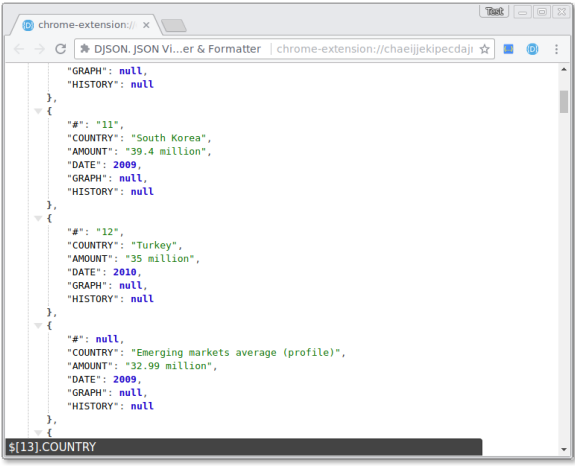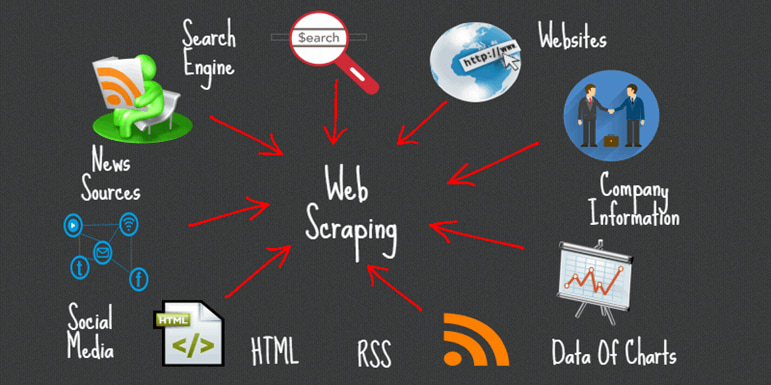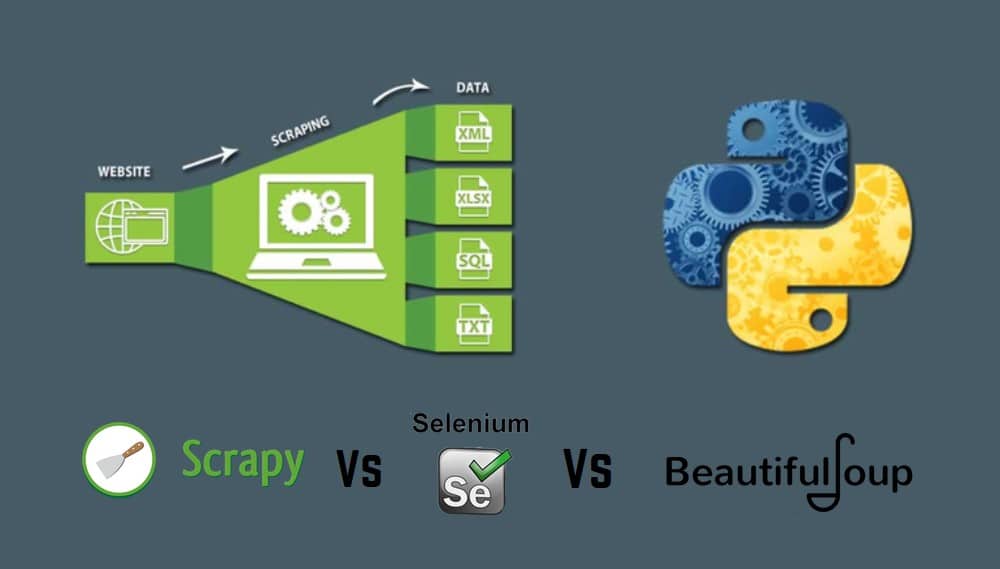Web Scraping with Pandas and Beautifulsoup. APIs are not always available. Sometimes you have to scrape data from a webpage yourself. Luckily the modules Pandas and Beautifulsoup can help! Related Course: Complete Python Programming Course & Exercises. Pandas has a neat concept known as a DataFrame. BeautifulSoup is an amazing parsing library in Python that enables the web scraping from HTML and XML documents. BeautifulSoup automatically detects encodings and gracefully handles HTML documents even with special characters.
- Web Scraping Python Bs4
- Python Beautiful Soup Web Scraping For Data Science Projects
- Beautiful Soup Python Web Scraping Tutorial
- How To Use Beautiful Soup
Web Scraping means navigating structured elements on a website, and deeply going to next layers. Incoming big data will be retrieved and formated in desired styles. We apply Python BeautifulSoup to a simple example for scraping with step-by-step tutorials.
All codes here are not complicated, so you can easily understand even though you are still students in school. To benefit your learning, we will provide you download link to a zip file thus you can get all source codes for future usage.
Estimated reading time: 10 minutes
EXPLORE THIS ARTICLE
TABLE OF CONTENTS

BONUS
Source Code Download
We have released it under the MIT license, so feel free to use it in your own project or your school homework.
Download Guideline
- Prepare Python environment for Windows by clicking Python Downloads, or search a Python setup pack for Linux.
- The pack of Windows version also contains pip install for you to obtain more Python libraries in the future.
THE BASICS
Python Web Scraping
Web pages are written using HTML to be structured texts. Therefore, people can obtain organized information of websites by scraping. Because Python is good at that, we will introduce its library BeautifulSoup in the article.
What is BeautifulSoup?
BeautifulSoup version 4 is a famous Python library for web scraping. In addition, there was BeautifulSoup version 3, and support for it will be dropped on or after December 31, 2020. People had better learn newer versions. Below is the definition from BeautifulSoup Documentation.
BeautifulSoup Installation

If you already download and setup Python and its tool pip in Windows or Linux, you can install BeautifulSoup 4 package bs4 by pip install command lines, and then check the result by pip show.
Scraping An Example Website
We should choose an example website to start. Focusing only on the content about laptop computer, thus the portion of an Indian shopping website, Snapdeal Laptops, will be suitable to our target.
Web Scraping Python Bs4
There are two layers, top layer for a product list and bottom layer for details in specification. For safety, we suggest a process of saving pages and then retrieve data from them. Therefore, the page contents along with images are downloaded. Below is the running process.
Next, you will learn how to scaping web pages by BeautifulSoup. The result will be saved as JSON format in a file named result.json.
STEP 1
Finding How Web Pages Link
The previous section let us know what type of data we will meet, so we need to inspect these HTML structured texts to find entry points for BeautifulSoup scraping to start.
Finding The Relationship
Python Beautiful Soup Web Scraping For Data Science Projects
Probably, the website you want to crawl has more layers than that in this example. As there is no general rule for various web pages, it is better to get a entry point that BeautifulSoup can start from by finding how web pages link.
Below lists the JSON-styled data related to a specific laptop computer. Except that the fields under 'highlight' is found from layer 2, other fields come from layer 1. For example, 'title' indicates the product name with brief specification, and 'img_url' can be used to download product pictures.
What to Inspect in Layer 1
From the view of HTML document, let us continue inspecting Layer 1 in file laptop.html. In other words, by going through HTML structured text, BeautifulSoup can locate the key feature of class='product-tuple-image' for scraping items like <a pogId=, <a href=, <source srcset=, and <img title= to be pogid, href, img_url, and title, respectively. Where href directs to url in Layer 2 for that product.
Similarly, with another feature of class='product-tuple-description', BeautifulSoup can continue scraping <span product-desc-price=, <span product-price=, and <div product-discount= to retrieve JSON fields price, price_discount, and discount. So far, all items in Layer 1 have been discovered.
What to Inspect in Layer 2
Further, BeautifulSoup traverses the HTML file of Layer 2 such as 638317853217.html. As mentioned previously, that is for detailed specification of laptops. The task in Layer 2 can be done by scraping items inside the feature of class='highlightsTileContent '.
STEP 2
Scraping By Beautifulsoup
Before scraping, we got to introduce a popular Python library PyPI requests to get contents from websites. Then, BeautifulSoup will perform iteratedly in layers to convert all information into JSON-style data.
PyPI requests
PyPI requests is an elegant and simple HTTP library for Python. In the following paragraph, we leverage it to read text from web pages and save as HTML files. Of course, you can install it by issuing pip install requests in command box.
Beautiful Soup Python Web Scraping Tutorial
PyPI requests requests.get() not only get web pages, but also pull down binary data for pictures like that in download_image().
Python Scraping in Layer 1
Let us start from getLayer_1() in which each web page has been saved before BeautifulSoup parsing proceed.
Saving contents as backup is helpful for debuging. Once exceptions happens while BeautifulSoup scraping, it is hard for you to find again the exact content you need from massive web pages. In addition to that, too frequent data scraping may trigger prohibition of some websites.
For BeautifulSoup, the very first expression like soup = BeautifulSoup(page, 'html.parser') need to select one kind of parsers. The parser could be html.parser or html5lib, whose difference can be found in Differences between parsers.
Based on understanding about what the text structure is in STEP 1, we find prices from the class of product-tuple-description by using attrs={} with which BeautifulSoup anchors a lot of locations in this example. Apart from prices, pictures are done in the same way.
Layer 1 can discover data about titles, images, and prices. Importantly, you should notice that BeautifulSoup uses find_all() or find() to gather information for all pieces or one piece, like the usage in database.
For each page in Layer 2, 'highlight': getLayer_2() is called iteratedly to retrieve more. Finally, json.dump() save JSON-formated data as a file. Subsequently, let us go through steps for BeautifulSoup scraping in Layer 2 in next paragraph.
How To Use Beautiful Soup
Python Scraping in Layer 2
Like the way in Layer 1, getLayer_2() find more product details by locating the class of highlightsTileContent. Then, in a loop, it store searched data in an array. You can check what is in this array in JSON style as discussed in STEP 1.
STEP 3
Handling Exception
BeautifulSoup scraping won’t be smooth continuously, because the input HTML elements may be partial missing. In that case, you have to take actions to avoid interrupt, and keep the entire procedure going on.
Why Will Exceptions Probably Occur?
In laptop.html, if every product has identical fields, there will be no exception. However, when any product has less fields than that of other normal products, it could happen like what the following Python scripts express.
Always, you have to deal with every kind of exception, so as to prevent the scrapying process from interrupt. Imaging that programs suddenly exit due to errors after crawling several thousands of pieces, the loss won’t be little.
What Exceptions to Handle

Here list only two conditions. However, you may encounter extra ones when scrapying more and more web pages.
KeyError means the HTML element to search for does not exist. You may have been aware of an alternative HTML element to replace with, thus in this example, you can replace find('img')['src'] with find('source')['srcset']. However, if no alternation, just ignore it.
FINAL
Conclusion
We didn’t write detailed skills in BeautifulSoup Documentation, but show many opinions and directions about scraping in Python. Therefore, if you are not familiar with skills, please refer to online resources for practices.
Thank you for reading, and we have suggested more helpful articles here. If you want to share anything, please feel free to comment below. Good luck and happy coding!
Suggested Reading
- 4 Practices for Python File Upload to PHP Server
- Compare Python Dict Index and Other 5 Ops with List
